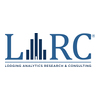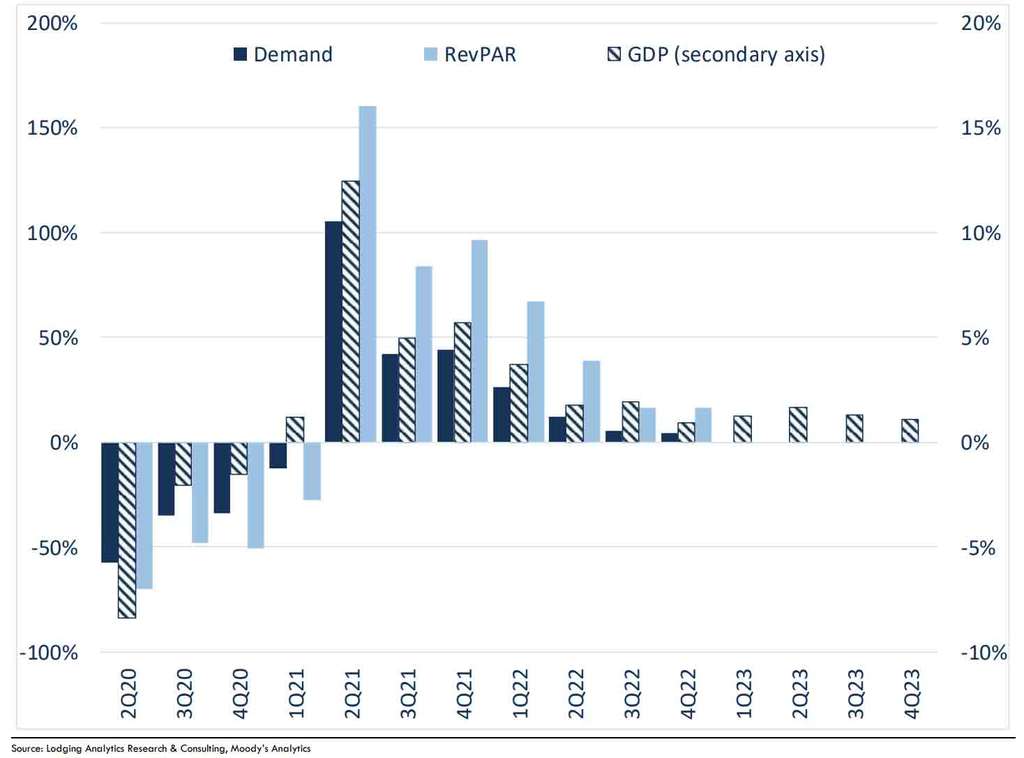Lodging Analytics Research & Consulting (LARC)’s 1Q-2023 Hotel Industry Outlook and Market Intelligence Reports
Notwithstanding continued economic uncertainty, Lodging Analytics Research & Consulting (LARC) remains encouraged by the U.S. lodging industry’s recent performance and our outlook for 2023 and beyond which his only modestly altered.
Macro-economic uncertainty permeated the 2022 year with GDP growth negative during the first two quarters and then meaningfully positive over the last two quarters, with 4Q-2022 GDP growth exceeding most expectations at 2.9%. Despite the acceleration in GDP growth, rising interest rates and the Federal Reserve Board’s (Fed) hawkish policies translated into an increasing fear of nearterm recession. In fact, the January 2023 Wall Street Journal economist survey pegs the probability of a recession within the next 12 months at 61%, consistent with the October survey, however more than three times higher than the 18% level from a year earlier.
While economic concerns continue to mount, they have not impacted lodging fundamentals as one might have expected. U.S. RevPAR rose 16% in 4Q-2022 on a yearover-year basis, driven by a 12% increase in ADR and a 4% increase in occupancy. Additionally, 4Q-2022 RevPAR was 13% above 2019 levels driven by ADR that was 16% above 2019 levels.
Lodging fundamentals are likely to remain strong in 1Q2023, aided by soft year-over-year comparisons from the impact of the Omicron variant in 1Q-2022. While declining economic activity has not had a meaningful impact on the lodging recovery to date, as the cycle shifts from recovery into expansion, economic activity will become a primary driver of performance. With the outlook for economic expansion remaining muted, it is our view that growth in fundamentals will substantially slow in 2023 and again in 2024.
While Moody’s Analytics (the economist we use) expects negative GDP growth in 1Q-2023 on a sequential basis, the risk of recession is now expected to be highest in 2024, not 2023, as had been the case. While the hope is that the U.S. will avoid an economic recession, it will depend on the Fed’s continuation of monetary policy tightening to combat inflation. The good news is that inflation levels appear to have peaked and begun to decline. The bad news is that the Fed has made no indication that it will take its foot off the proverbial gas.
Despite soft economic growth and rising inflation, leisure travel was incredibly strong in 2022. While 3Q-2022 leisure demand set records for the lodging industry, it is also likely that was the peak for several years. Moving forward, industry growth will need to be fueled by the corporate and group segments. We remain optimistic that these segments will continue to recover, however they can be sensitive to economic downturns, creating a considerable amount of uncertainty over the next couple of years.
Additionally, the corporate recovery will be somewhat dependent on the return to the office, which we expect to continue to gradually progress through 2023. Furthermore, group trends appear robust, helping generate a base level of demand that will further support pricing power. Nationally, we estimate that the convention center booking pace is up 12% on a year-over-year basis in 2023.
Our economic forecast from Moody’s Analytics incorporates the following key national assumptions:
- The Fed will raise rates by another 25 bps in early 2023, then pause rate increases until rate cuts begin in 2024.
- Inflation will drop to under 3% by 3Q-2023.
- U.S. GDP will decrease 0.4% in 1Q-2023 and increase 1.3% for the full year. Growth will then modestly accelerate through 2025.
One of the reasons that lackluster GDP growth has not had much effect on lodging demand and RevPAR growth is that the metrics are primarily assessed on a different basis. Lodging demand and RevPAR growth are measured on a year-over-year basis (i.e., 3Q-2022 RevPAR over 3Q2021 RevPAR, while GDP growth is measured on an annualized quarter-over-quarter basis (i.e., 3Q-2022 GDP over 2Q-2022 and annualized). However, analyzing data on a comparable basis (year-over-year growth rates) we notice that the historical relationships between national GDP and lodging demand and RevPAR generally held throughout the pandemic and during the recovery.
While there have been limited data points, since the start of 2020, year-over-year U.S. GDP growth has had a 96.8% correlation with U.S. lodging demand growth and a 93.0% correlation with U.S. RevPAR growth. More importantly, the R-squareds are also very strong as yearover-year U.S. GDP growth has a 93.7% R-squared with U.S. lodging demand growth and an 86.5% R-squared with U.S. RevPAR growth.
Year-over-Year Growth in U.S. GDP vs. Year-over-Year Growth in U.S. Lodging Demand and RevPAR
U.S. lodging fundamentals have not decoupled from economic activity as headline numbers might suggest. However, with muted GDP growth (on a year-over-year basis) moving forward, the data also points to a considerable slowing in lodging demand and RevPAR growth in 2023.
With that said, that relationship has broken down at the market level. This cycle has generated lodging industry winners and losers that have had no relationship with MSAlevel economic output.
In fact, across the 49 markets we cover, 2022 RevPAR growth over 2019 levels has a 1.2% correlation with 2022 gross metropolitan product (GMP) growth over the same period. In other words, since the pandemic began, economic growth has had little, if any relationship with outperformance or underperformance across given markets. For example, comparing 2022 vs. 2019 in San Jose, CA, RevPAR growth was (30)% while economic growth (GMP) was 19%. Another example is Mobile, AL where 2022 RevPAR was 27% above 2019 levels, while GMP was unchanged over the same period.
As this cycle moves into the next phase of growth, it would be wise not to rely on basic economic growth estimates or those factors that drove outperformance over the initial phase of the recovery. Instead, sector participants will need to granularly understand the local macro-economic drivers of lodging demand and pricing power to accurately assess future market performance, particularly to take advantage of market dislocations that may occur in the near-term. LARC provides accurate, transparent, and detailed data to decipher between winning and losing markets.
RevPAR vs. Economic Growth by Market: 2022 over 2019
We continue to expect there to be U.S. lodging markets that materially outperform as well as those that underperform national averages. As the lodging industry shifts into the next stage of the cycle, we generally believe leisure markets will begin to cool, while international gateway markets should experience stronger growth, however, take the longest to fully recover to pre-pandemic levels.
We believe the best business decisions are based on the best information available at the time of making that decision. We take that approach with our forecasts, using the best available information to provide the most likely outcome. As such, we believe transparency surrounding forecasting is critical to the lodging industry.
LARC’s industry-leading market intelligence referred to throughout this document can help all industry participants navigate the current environment and position themselves for success as the industry navigates these turbulent times. Please contact us directly to learn more about our services and products and if there is any other way we may be able to better serve you.
LARC’s Industry Outlook
Currently, Lodging Analytics Research & Consulting (LARC) expects U.S. RevPAR to increase by 6.3% to $99.15 in 2023, resulting in an annual RevPAR that is 15% above 2019 levels. LARC anticipates ADR to rise by 4.3% this year to $155.29, or 19% above 2019 levels, while occupancy will increase 1.9% to 63.8%.
Despite challenging capital markets, LARC anticipates 2023 U.S. Hotel EBITDA to grow by 10% and Hotel Values to increase 6%. LARC estimates that 2022 Hotel Values were just 1% below 2019 levels and that both Hotel Values and Hotel EBITDA will reach 2019 levels in 2023.
March 2023 U.S. Hotel Industry Forecast Summary
LARC’s U.S. RevPAR model has an R-squared of 99.5% with a standard error of 4.9%, back-tested to 2000. LARC’s U.S. Cap Rate model has an R-squared of 98.4% with a standard error of 26 bps, back-tested to 2005.
The following table illustrates a summary of LARC’s current U.S. Hotel Industry Outlook in contrast to last quarter’s outlook. Ultimately, our 2023 outlook for demand and occupancy increased slightly, while our forecast for ADR came down a bit, resulting in a modest reduction in RevPAR growth. However, as our outlook for expense growth moderated (but remains elevated), Hotel EBITDA growth improved, driving Hotel Value growth higher.
2023 U.S. Hotel Industry Forecast: March 2023 Edition vs. December 2022 Edition
Market Outlooks
Below is a list of the best and worst performing markets based on our forecasts. Similar to LARC’s U.S. forecast, our market level forecasts are built entirely on multivariable regression models with high historical accuracy.
More detail on our market outlooks can be found in LARC’s Market Intelligence Reports. Please contact us if you are interested in purchasing any of LARC’s offerings.
2023 (relative to 2019)
Top Markets for RevPAR Growth:
Palm Beach, Orlando, Phoenix, Puerto Rico and Mobile
Bottom Markets for RevPAR Growth:
San Jose, San Francisco, Portland, Minneapolis and Boston
2023 (year-over-year)
Top Markets for RevPAR Growth:
San Francisco, San Jose, Houston, Minneapolis and Orlando
Bottom Markets for RevPAR Growth:
Miami, Omaha, Mobile, Tampa and San Diego
2019 - 2027 Outlook
Top Markets for RevPAR Growth:
Palm Beach, Las Vegas, Orlando, Memphis and Tampa
Bottom Markets for RevPAR Growth:
San Francisco, Louisville, Portland, San Antonio and Kansas City
Top Markets for Value Change:
Puerto Rico, Tampa, Los Angeles, Las Vegas and Nashville
Bottom Markets for Value Change:
San Francisco, Portland, Boston, New York and Philadelphia
Ryan Meliker
President
Lodging Analytics Research & Consulting, Inc








